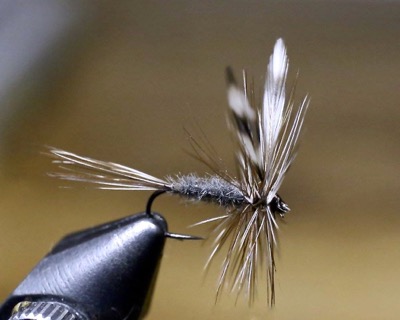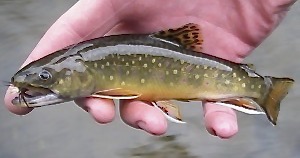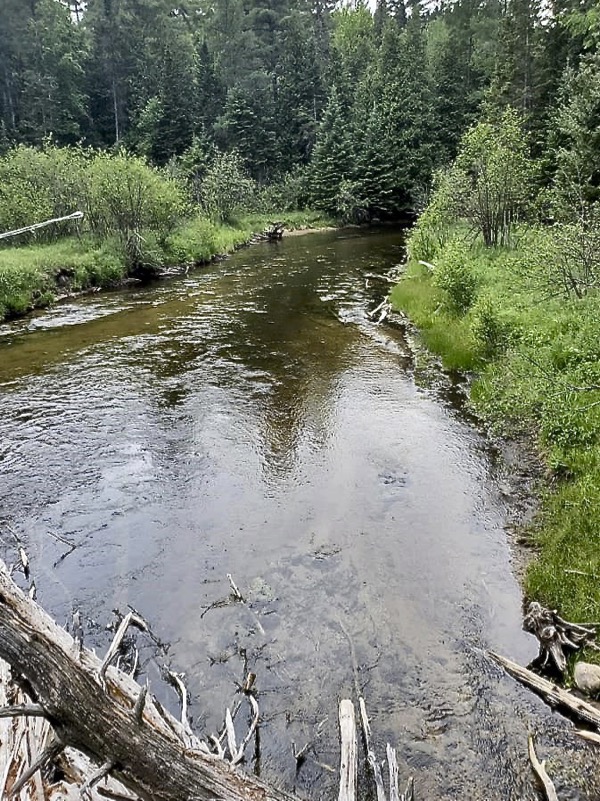Fly fishing for trout, like life, is often about the journey and not the destination. It’s fine, and those that do like it that way.
 Fly fishing has always been a bit of a paradox for me, especially if the quarry is one of the beautiful and finicky trout species. It can be humbling, frustrating, sometimes exhausting and reward you with an unintended; but not totally unexpected, baptism. With all of these negatives, some may ask, “Why?” Fly fishing is also a gratifying experience with each trip reviving a naturalist’s awareness – whether or not a big fish, little fish or no fish are brought to net.
Fly fishing has always been a bit of a paradox for me, especially if the quarry is one of the beautiful and finicky trout species. It can be humbling, frustrating, sometimes exhausting and reward you with an unintended; but not totally unexpected, baptism. With all of these negatives, some may ask, “Why?” Fly fishing is also a gratifying experience with each trip reviving a naturalist’s awareness – whether or not a big fish, little fish or no fish are brought to net.
All of this proved itself once again while visiting Michigan’s restored Boardman River which runs just a bit more than 28 miles from Kalkaska to Grand Traverse Bay in Traverse City. Once dotted with a series of dams, the removal of several have helped the river recover much of its historically wadable waters. Today, it’s considered one of Michigan’s top-10 trout streams.

Retired wildlife officer Jim Abrams regularly writes about the great outdoors for Press Pros Magazine.
My first day on the water was on a Friday, deliberately planned to avoid the expected weekend rush of kayaks, canoes and anglers. The weather was dry, the sun high and hot and the daytime insect hatches were sparse. Whether you see bugs in the air or not, it’s worth remembering that trout are predators. If there’s no food floating on the surface, then they’re hunting below. Fishing tactics will necessarily need to follow the trout’s own strategy, unless you happen to be stubborn. That may sound simple but many things that do, are not.
I arrived mid-morning at the Brown Bridge Access and was surprised to be the only car in the lot. I put together my rod and was struggling into chest waders when another vehicle parked nearby. As the man unloaded camera equipment we struck up a bit of a conversation. His goal was to photograph wildflowers but added that he’d be sure to snap my picture when I caught the big one. I smiled and thanked him – the jinx was in.
I was soon walking along the river’s edge and looking at the insect activity. As mentioned, it was scarce. A few butterflies, the occasional ubiquitous house fly and high-spiraling dragon flies chasing some very small ‘what-is-its’…my term, not sciences’. There wasn’t a single Mayfly or cadis on the wing. After traversing 100 yards upstream away from the parking area, I stepped into the chilly water. It felt great compared to the 85 degree temperature.
I knotted on a dark parachute Adams Mayfly imitation because it was easy to track on the water, there’s no other hand-tied fly more synonymous with the Boardman River – and I’m stubborn. The casting began. Finally, a little brook trout couldn’t resist, was brought to hand and quickly released.
 On occasion, I would glimpse the fleeting ghost of a trout darting away from a hiding place behind a current-interrupting rock or log. There’s no doubt that the bright sun and my wading made the fish wary. I’m also sure that the jinx was in full effect. I reluctantly tried a weighted nymph and was rewarded with another small brookie.
On occasion, I would glimpse the fleeting ghost of a trout darting away from a hiding place behind a current-interrupting rock or log. There’s no doubt that the bright sun and my wading made the fish wary. I’m also sure that the jinx was in full effect. I reluctantly tried a weighted nymph and was rewarded with another small brookie.
Walking against the current was relatively easy at the Boardman’s summer-shrinking water levels. Moving slowly with the occasional stop to untangle a line, change a fly or unwrap a snagged over-hanging willow allowed me to blend into the background. A young whitetail buck crossed the river silently just 50 yards upstream with only a curious glance in my direction. Once out of the water, it shook like a wet dog then vanished into the trees.
After moving upstream, I took another pause and a chestnut-sided warbler landed on a limb near my rod tip then flitted off. I had to look that one up to verify its identity. I’ve never been great at figuring out the warbler clan. At the time I was switching back to a parachute Adams; success or not, dry flies are more fun to fish and stubborn is truly a hard fault to fix.
 Continuing on with my wading and casting, another little trout took the dry and was quickly returned. A lone mallard drake quacked at the intrusion and drifted by, not concerned enough to take flight. It was time to check my leader. Two wind-knots had magically appeared due to some casting miscues.
Continuing on with my wading and casting, another little trout took the dry and was quickly returned. A lone mallard drake quacked at the intrusion and drifted by, not concerned enough to take flight. It was time to check my leader. Two wind-knots had magically appeared due to some casting miscues.
While repairing the line, another traveler drifted by just under the water’s surface, attempting to use my leg as a break. This local resident was a large snapping turtle and its pawing attempts at my knee were useless. The current swept it by as I smiled at his seemingly familiar frustrated maneuvering.
The last fish of the day was the largest. It ambushed the Adams with a shark’s aggression. Its sides flashed in the crystalline waters then it took to the air in a shaking leap allowing me a glimpse of shining gold as its strength – its very existence –was transferred to my hand. Once more in the water, it made another twisting run and was gone. A decent brown trout; the one that got away. I smiled. Good for him, he won.
More than four hours had elapsed and it was time to head back to what some call civilization. I climbed a sandy hill and; still wearing waders and carrying my gear, I took the mile-long trek back to my car. On the way, I woke a day-dreaming barred owl which caught the attention of an irritable redwing. The owl silently escaped into the Boardman’s bordering pines to continue his nap while waiting for the moon to rise.
 I was sweating, tired and had landed exactly three fish which were all returned to the water. None would classify as much more than bait to some but those trophies don’t mean much to me. The trip was my trophy and by my standard, it was world class.
I was sweating, tired and had landed exactly three fish which were all returned to the water. None would classify as much more than bait to some but those trophies don’t mean much to me. The trip was my trophy and by my standard, it was world class.
“Fly-fishing is solitary, contemplative, misanthropic, scientific in some hands, poetic in others, and laced with conflicting aesthetic considerations. It’s not even clear if catching fish is actually the point.” – John Gierach
Jim Abrams is a retired wildlife officer supervisor for the state Division of Wildlife in Findlay. He can be reached at P.O. Box 413, Mount Blanchard, OH 45867-0413 or via e-mail at jimsfieldnotes@aol.com.

Coverage of the outdoors on Press Pros is proudly sponsored by Olde English Outfitters, in Tipp City.

